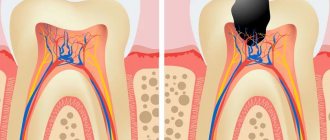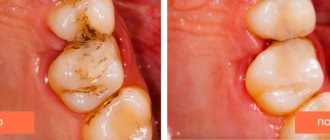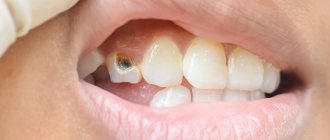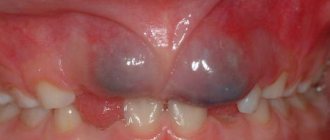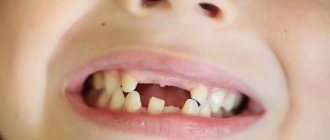Do you want to know in detail what dental caries is, how to treat it and the causes of its occurrence? This dental problem is physiological and aesthetic in nature. Damage and gradual destruction of tooth enamel can cause a person a lot of unpleasant experiences. To prevent the disease from progressing, it is necessary to treat it in a timely manner. Are you interested in the question of when to treat caries? Depending on the stage of the disease and the speed of its progression, you have a varying amount of time at your disposal. At any of its stages, it is best to seek medical help as quickly as possible in order to avoid much more serious consequences for your health.
How does caries develop and what are the consequences?
Conventionally, there are 3 stages of caries:
1
2
3
- Superficial caries (or spot caries)
- Average caries, when tooth decay is only at the enamel level
- Deep caries, when a cavity forms in dentin
If caries has reached the pulp (the soft tissue of the tooth with blood vessels and nerves), then doctors call it pulpitis. Typically, pulpitis is accompanied by severe and persistent pain, which even prevents sleep.
If pulpitis is not cured, a complication will appear, inflammation of the jaw bone tissue or, in medical terms, periodontitis.
- Caries
- Pulpitis
- Periodontitis
Caries is a source of infection in the oral cavity. It not only imperceptibly deteriorates teeth, but also undermines a person’s overall health.
At the initial stage, caries can be easily, completely and inexpensively cured. By postponing a trip to the dentist, a person does not save, but on the contrary, significantly (manifold!) increases the cost of his treatment.
If at the initial stage treatment would cost up to 2,500 rubles, then treatment of pulpitis of one tooth may require about 15,000 rubles. Most often, the costs are more modest, but if you delay going to consultation and treatment, the situation will only get worse.
Caries leads to tooth loss. Even the absence of one tooth brings a lot of inconvenience (it is inconvenient to eat, aesthetics suffer, asymmetry occurs on the face, other teeth are displaced).
And the loss of several is a tragedy for the body. Dozens of people who have experienced this themselves contact us every month. They come to get implants to restore comfort and eat, smile and live with pleasure again. Implantation is a high-tech treatment that requires expensive materials, equipment and enormous doctor qualifications. Therefore, a new artificial tooth costs 60,000-100,000 thousand. It’s not cheap, but those who have experienced a life full of restrictions and inconveniences due to the absence of a tooth(s) already understand the value and know that it’s worth it.
Causes of dental problems
The occurrence of a problem such as caries is associated with the destructive effect of bacteria on the structure of the teeth. The microflora in the oral cavity includes a huge number of microorganisms. Even proper and thorough brushing of teeth with special means and the use of rinses cannot make the oral cavity completely sterile. The proliferation of pathogenic bacteria begins 2-4 hours after the last cleaning.
What exact reasons can cause tooth damage?
- poor oral care;
- unbalanced diet;
- decline in immunity;
- gastrointestinal diseases;
- avitaminosis;
- insufficient amount of minerals (calcium, fluorine) in drinking water.
Stage of carious spot
The carious process begins in the tooth enamel and over time appears as a stain on the surface of the tooth. The stain is not necessarily dark. On the contrary, it can be lighter than the natural color of the enamel, or translucent. A spot color defect is the only sign of caries at the initial stage.
At this stage, the tooth does not hurt and does not cause any discomfort. If caries develops on the inside of the tooth, a person does not see a change in the color of the enamel and does not suspect that a pathological process has begun.
For these reasons, patients rarely go to the dentist to treat caries at the initial stage. And in vain. When the carious process has just begun, it can be stopped by remineralization. This is an effective and painless method of restoring tooth enamel. As long as caries has not gone beyond the enamel, treating the tooth is not only easier, but also much cheaper.
Superficial caries
If the carious process is not stopped at the stain stage, it progresses and enters the next stage - superficial caries. Pathological changes at this stage do not yet go beyond the enamel layer and do not affect the internal tissues of the tooth. Since the dentin is not damaged, the tooth does not hurt, but discomfort may occur when a person eats or drinks something hot or cold. Discomfort may occur while brushing your teeth. Most people ignore the clinical signs of superficial caries or consider them to be symptoms of tooth sensitivity.
Externally, the carious process at this stage appears in the form of a rough whitish spot. But you can see it yourself only if the pathology is localized on the front side of the front teeth. If caries develops on the inner or lateral surface, it is difficult to detect it on your own. It will no longer be possible to cure superficial caries without a drill, but the treatment itself will be quick and painless for the patient.
We recommend that you read
Dental treatment during pregnancy
Treatment of anterior teeth
Dental filling
Canal filling
Average caries
If the pathological process has reached this stage, it is already difficult for a person to ignore its symptoms. A carious tooth reacts more often and more sharply to cold and hot, and may hurt when in contact with sweet foods and drinks. But, as soon as the irritant disappears, the pain goes away quite quickly.
Visual symptoms also change. The carious spot darkens. A small cavity may also form on it. If a cavity has formed on the front wall of the tooth, you can see it; if on the back, you can feel it with your tongue. Food debris gets clogged into the cavity, and this provokes a new sign of caries - an unpleasant odor in the mouth and “stuffy” breath.
Treatment of caries at this stage is more complex and often requires pain relief, since the pathological process has affected the internal tissues of the tooth. The doctor uses a drill to remove all affected dentin and fill the cavity with filling material.
Middle caries is the last stage at which pathology can be eliminated without serious long-term therapy. If you do not see a doctor, tooth decay will continue and move to the next stage - deep caries.
Deep caries
At this stage, the tooth is almost completely destroyed. Often in patients with deep caries, only a couple of walls remain. The carious process reaches the pulp, fibrous connective tissue with nerve endings, and can provoke the development of pulpitis and then periodontitis.
It is difficult to ignore the symptoms of deep caries; the tooth reacts to any irritant - cold, hot, sweet, sour. Even when a person breathes in cold air, severe pain can occur. External signs are also more obvious: the cavity is visible visually, it can be easily “detected” with the tongue.
Treatment of deep caries is a complex and multi-stage process. At the first visit, the dentist opens and cleans the cavity from destroyed tissue and sanitizes it. If there is a suspicion of pulp inflammation, the doctor puts anti-inflammatory drugs into the cavity and places a temporary filling, which is left in place for several days. If during this period the tooth does not bother the patient, the dentist will place a permanent filling at the next appointment. Otherwise, the doctor removes the dental nerves, sanitizes and fills the canals, and again places a temporary filling. If after root canal treatment the patient feels well and the tooth does not hurt, the temporary filling is replaced with a permanent one.
Deep caries is almost always treated under anesthesia, so the procedure is painless for the patient. If you do not consult a dentist at this stage, more serious complications may follow that will require lengthy and expensive treatment. In many cases, it is not possible to save a tooth with complicated deep caries.
Caries of anterior teeth
When caries affects the front teeth, a person is faced with two problems at once - pain and psychological discomfort. The front and lateral incisors themselves are more sensitive and are the first to come into contact with hot, cold, sweet foods and drinks. Therefore, acute pain can occur even at the stage of superficial caries. The aesthetics of the smile also suffers. Carious front teeth are visible to everyone around and the person becomes uncomfortable communicating.
You need to contact your dentist as soon as the first signs of caries appear - at the initial stage. If the destruction starts and the carious process covers a large area, the tooth will not only need to be treated. To make your smile beautiful again, the tooth will have to be restored with composite materials or veneers. Veneers are a more aesthetic, durable option, but also more expensive and difficult to implement.
Of course, the resulting cavity can simply be filled, but it is not always possible to select a filling material that is identical in color to tooth enamel. Plus, over time, the filling will darken and will need to be replaced. If caries is advanced and more than half of the tooth is destroyed, it will have to be restored with the help of a crown. The cost of treatment in this case will increase significantly.
It is difficult to treat caries on the front teeth, since the doctor must not only remove all the affected tissues, prevent the re-development of the pathology, but also restore the aesthetics of the dentition. To make the filling invisible, you need to accurately select the shade of the filling material and recreate the anatomical shape of the tooth. Only a doctor with rich practical experience can do all this.
Diagnostics
- visual examination of the oral cavity
. It is performed using special instruments to assess the condition of the oral cavity. A dental mirror allows the specialist to carefully examine the distal surfaces: to detect the localization of spots, stripes/dots of black, brown color, and a carious lesion in the gap. The probe helps differentiate the depth of the cavity; - percussion method
. Intended for diagnosis and identification of pathological segments by tapping. The diseased unit reacts with a muffled sound, the patient experiences pain and severe discomfort; - radiography
. The x-ray image shows the distance of the lesion from the pulp, the level of prevalence of the process; - transluminescence
. Luminescence (transmission through a filter with an ultraviolet beam) and fiber optic exposure (transmission with a light beam) are practiced. Damaged areas appear darker than healthy areas; - coloring
. Application of staining markers (potassium iodide/methylene blue solution). The technique allows you to diagnose pathology and distinguish it from fluorosis/hypoplasia.
In difficult cases, fissurotomy (opening the grooves on the surface of the molars) and electroodontometry are used to determine the degree of pulp damage.
Tooth root caries
This type of caries is rarely diagnosed at the initial stage. A person cannot see the darkening or a small cavity on his own, since the roots of the tooth are hidden in the gum. The patient turns to the doctor when the tooth begins to hurt, and this is already medium or deep caries.
A tooth with root caries cannot always be saved. The dentist decides whether to treat or remove the tooth after diagnosis. If a significant part of the tissue is destroyed, but there is a chance to save the tooth, the doctor recommends surgical treatment. If the carious process has affected most of the tissue, in most cases the tooth has to be removed and then prosthetic treatment or an implant installed.
Prevention
Preventing the development of interdental caries is quite simple. To do this, it is enough to follow the recommendations of dentists:
- It is recommended to clean your teeth after each meal, moving the brush up and down to remove as much food debris as possible in hard-to-reach places. For care, use pastes that improve the protective properties of enamel.
- Rinse your mouth several times a day. It is not necessary to use special solutions; boiled water will be enough for cleaning. Additionally, use an irrigator.
- It is better to avoid foods such as chips, chocolate, and crackers, as their particles settle tightly in the interdental space and become a haven for bacteria. As a last resort, carry dental floss with you.
- Visit your dentist's office every six months for a checkup and professional cleaning.
To find out the cost of treating caries between teeth, sign up for a consultation at Dr. Razumenko’s dental clinic in Moscow by phone.
